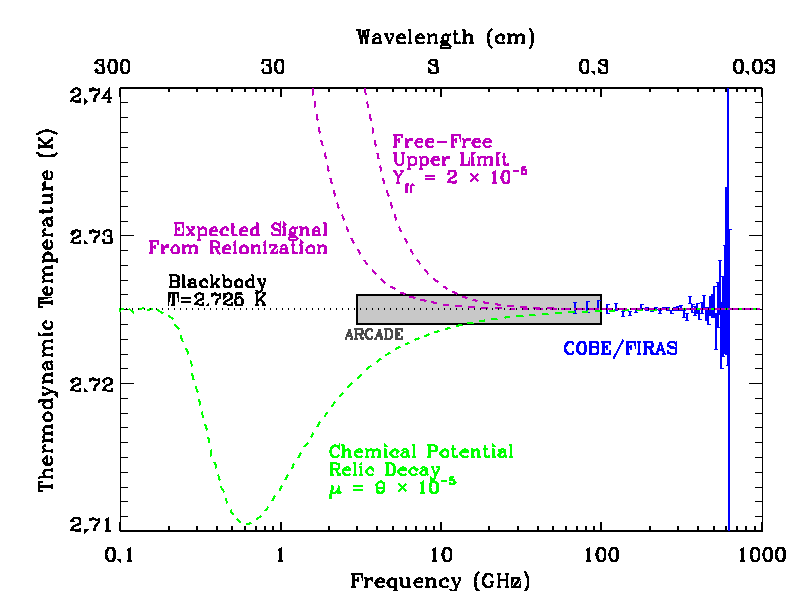 |
 |
Relic Particle Decay
The cosmic microwave background is the primary reservoir of photons
in the universe,
and serves as a heat sink for energetic processes.
Energy released in the form of photons or charged particles
will interact with the CMB and distort the spectrum away
from the equilibrium blackbody form.

Consider a photon gas
interacting with a (hotter) electron gas.
The photons scatter off the electrons
(Compton scattering)
and will, on average, gain energy.
Since the photon number is conserved
(no new photons are created),
the effect is to shift
the original photon spectrum (solid curve)
to higher frequencies or higher energies (dashed curve).
If scattering is rare,
the gas is optically thin
and we obtain the Sunyaev-Zeldovich effect:
compared to the original spectrum,
the shifted spectrum
has too few photons
in the long-wavelength Rayleigh-Jeans portion of the spectrum
and too many photons in the short-wavelength Wein tail.
This effect is commonly observed
in the CMB
observed along the line of sight through large clusters of galaxies.
At very early times
(redshift between 10^4 and 10^7),
each CMB photon can scatter multiple times
and the gas becomes optically thick.
Since the photon number is still conserved,
the system approaches statistical equilibrium
but not thermal equilibrium.
The resulting photon spectrum
is characterized by the chemical potential,
which in turn
is proportional to the
ratio of the electron energy to the CMB energy.

Measurements of the CMB spectrum
are thus sensitive probes
for energetic processes in the early universe.
Consider the decay (or annihilation)
of dark-matter particles in the early universe.
Any charged or photonic decay products
will heat the electron gas,
producing a chemical potential distortion
with amplitude
proportional to the integrated energy release.
The
plot above
shows the resulting spectrum
(green curve),
characterized
by a sharp drop in temperature
at wavelengths longer than a few cm.
Recent analyses of gamma ray emission
hint at a signal from annihilating dark matter
toward the Galactic center.
Since the annihilation rate varies as z^6,
annihilation in the early universe
could produce a measurable energy input,
resulting in a detectable distortion.
Measurements of the CMB spectrum
can provide important constraints on
dark matter properties
and high-energy physics.
ARCADE will measure the chemical potential of the CMB
to sensitivity mu < 2 x 10^{-5}, a factor of 5
more sensitive than existing limits.
|
|


